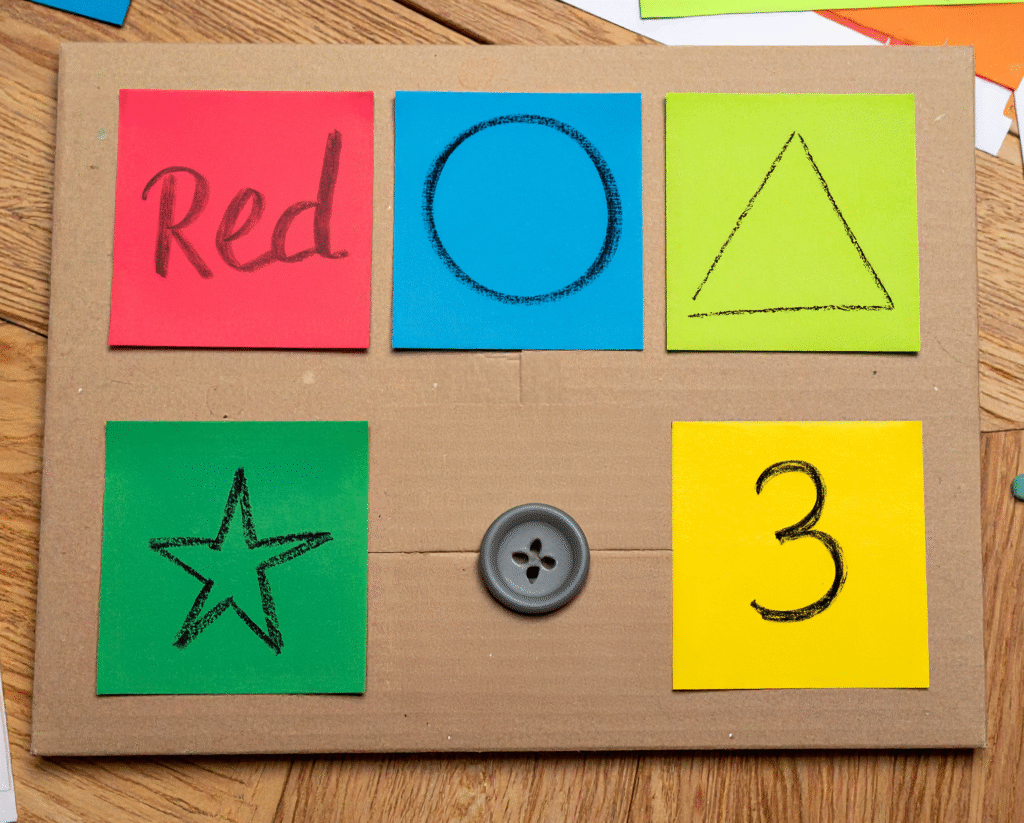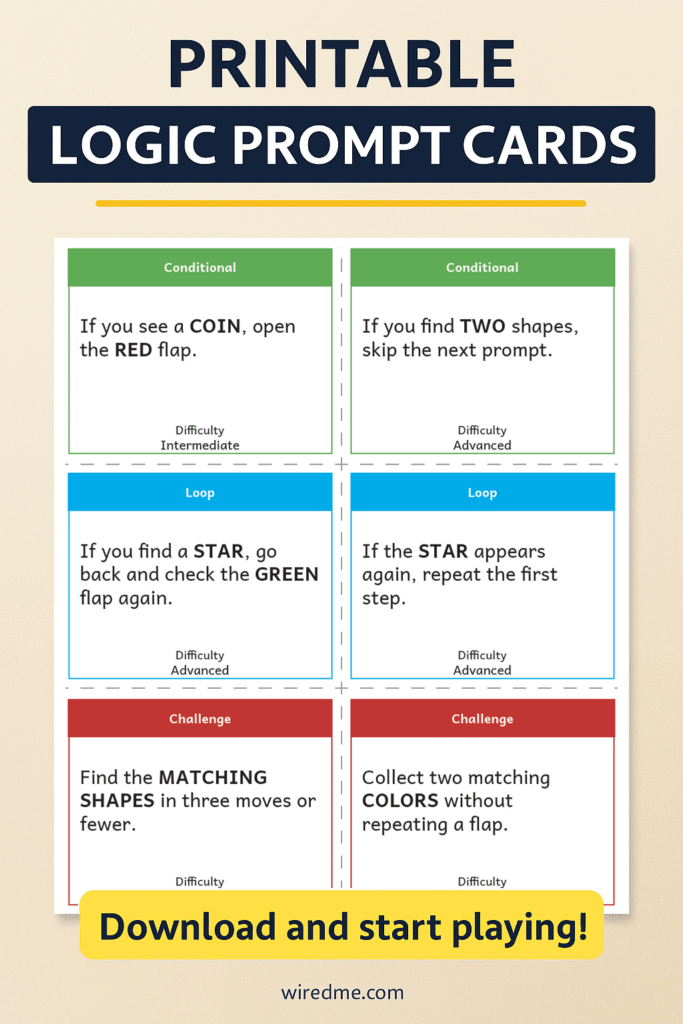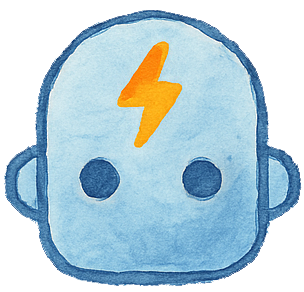Looking for a hands-on way to teach coding at home or in the classroom? A logic puzzle for kids offers a simple, screen-free activity that introduces concepts like loops and conditionals. Using only a cardboard box and a few household items, you can create a powerful learning tool that’s both fun and educational.
As kids follow printed instructions, lift flaps, and react to what they find, they begin to develop real logic skills. Each challenge builds confidence and sharpens problem-solving abilities. Best of all, kids love the process.
What Is a Logic Puzzle for Kids?
A logic puzzle for kids is a physical activity that helps children solve problems using clear, step-by-step thinking. In this version, you’ll build a logic box with paper flaps and tokens hidden underneath. Children follow prompt cards with instructions like:
- If the red token is on top, open the red flap
- If there’s a triangle underneath, move forward
- If you find a star, go back and check the green flap
Through repeated play, kids begin to understand how input leads to output. This is the same thinking behind basic coding logic.
Why This Logic Puzzle for Kids Works
This puzzle is more than just a fun challenge. It also teaches real problem-solving skills. When kids follow a specific sequence, they learn how to apply logical reasoning.
Additionally, this type of hands-on activity strengthens memory and attention. Children must observe, analyze, and adapt based on new information. With each turn, they build habits of careful thinking.
Eventually, this kind of learning leads to deeper understanding. As kids practice, they begin to approach puzzles like developers. They break problems into parts and test solutions one by one.
How to Build a DIY Logic Puzzle for Kids
Getting started is easy. You can use materials you likely already have at home.
Materials:
- One shoebox or small piece of cardboard
- Colored paper or sticky notes
- Tape or glue
- Scissors
- Coins, tokens, or buttons
- A marker
- Optional: printed prompt cards
Instructions:
Step 1: Build the Puzzle Box
- Use a shoebox or small cardboard box.
- Use 4 to 6 sticky notes or cut 4 to 6 flaps into the top of the box. These should act like small doors that lift open.
- Label each card or flap with a color, shape, or number.
For example, use “Red,” “Star,” “3,” or “Triangle.” - Place one small object under each flap. This could be a coin, a sticker, a paper shape, or anything else you have on hand.

Step 2: Create Prompt Cards
Make simple instruction cards using “if–then” logic. There are two types of prompts:
Action prompts tell the child which flap to open.
Example:
“Open the flap labeled Red.”
Conditional prompts tell the child what to do based on what they find.
Examples:
“If you find a circle, open the Yellow flap.”
“If the flap is empty, go back and try the Blue flap.”
A good puzzle uses both types. Start with action, then follow with conditionals.
Step 3: Start the Puzzle
- Hand your child one prompt card at a time.
- If the card gives a direct instruction, they open the flap named.
- Look at what is underneath the flap.
- The next card will tell them what to do based on what they found.
- If the condition is true, they follow the instruction.
- If the condition is false, they skip that step and move on to the next prompt.
This teaches how logic works in a real program. Computers also skip any instructions that don’t meet the condition.
Expand the Logic Puzzle for Kids
Once your child understands how the puzzle works, encourage them to make their own prompts. This step helps them think more creatively and apply their learning in a new way.
You can also increase difficulty as they improve. Try combining clues, creating simple loops, or adding rules like:
- If the red flap is empty, check all others before choosing
- If the blue flap shows a square, skip the next card
- If you find two of the same shape, restart the puzzle
By designing their own logic puzzle for kids, they become the teacher. This reinforces their learning and builds long-term confidence.
Download the Printable Logic Prompt Cards
Ready to start playing? We’ve created a set of 12 printable logic prompt cards you can use with your puzzle grid.
Each card includes:
- A clear prompt
- The card type (Action, Conditional, Loop, or Challenge)
- A kid-friendly difficulty level (Beginner, Intermediate, or Advanced)
You can print, cut, and reuse them during play or let your child create new cards using the same format.

Perfect for homeschoolers, classrooms, or afterschool logic games.
Frequently Asked Questions
What age is a logic puzzle for kids best for?
This DIY logic box works well for kids ages 5 to 9. Younger children enjoy exploring the flaps, while older kids grasp coding logic like loops and conditionals.
Can I use this logic puzzle in a classroom?
Yes. Teachers can easily adapt this project for group learning or centers. It encourages collaboration, sequencing, and critical thinking.
What skills does this puzzle teach?
Kids learn logical thinking, sequencing, conditionals (if–then logic), problem-solving, and even basic looping concepts used in computer programming.
What if I don’t have tokens or shapes?
You can substitute with paper scraps, coins, bottle caps, or hand-drawn symbols. The activity is flexible and works with what you have.
Do I need a background in coding to teach this?
Not at all. This puzzle is designed for parents and teachers without any coding experience. Just read the prompts and let the puzzle guide the logic.
Try More Logic Puzzles for Kids
Interested in additional screen-free ways to teach logic? Visit CS Unplugged – Binary Numbers to explore more printable logic puzzles that build real computational thinking.
You can also check out our screen-free coding activities collection for unplugged ideas that support both home and classroom learning.
Ready to Build a Logic Puzzle for Kids?
This project is a creative, low-prep way to build logic skills in early learners. By using real materials and clear instructions, you create a puzzle that teaches coding fundamentals in a way that’s playful and lasting.
Whether you homeschool or teach in a classroom, this activity makes logic come alive. Try it today and see how quickly kids begin thinking like real coders.


Leave a Reply